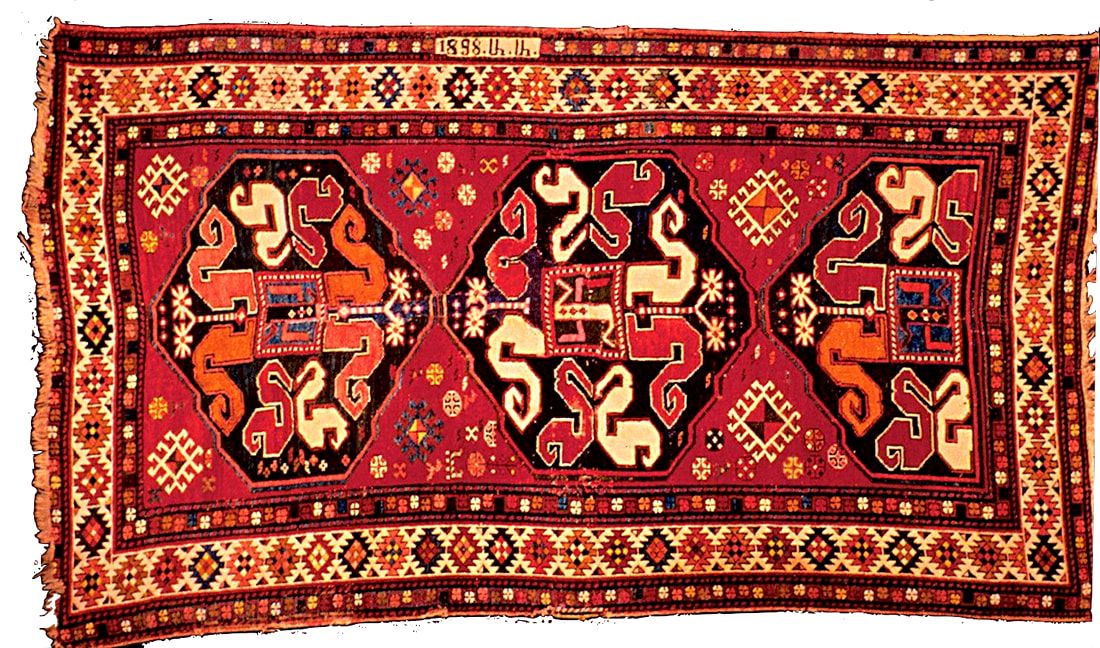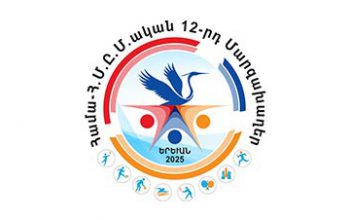Ara Mgrdichian
CULTURAL APPROPRIATION
THE AZERI CAMPAIGN TO CLAIM ARMENIAN ARTS AS THEIR OWN
Azeris Portray Ancient Armenian Textile and Woven Arts Culture as Being an Azerbaijani Turkish Tradition
Armenian woven arts traditions are rooted across the Armenian Highland and beyond, all along a vast millennial landscape of Armenian trajectories, indigenous and migratory, forced and of their own volition. These traditions have been passed from generation to generation, for thousands of years, by highly skilled artisans who have produced and continue to produce stunning works of staggering beauty.
Fortunately, Armenian woven arts culture has continued to flourish over these many centuries despite the manifold life-threatening obstacles it has faced and is facing now.
However, unfortunately, its detractors and their attempts at destroying Armenian arts have grown, as well.
The governments of Turkey and Azerbaijan continue to eradicate Armenian monuments, architectural sites, churches, monasteries, and precious cross-stones whenever they are able. And, when they are unable to physically decimate indigenous Armenian high arts, they attempt to appropriate these works and purposefully distort their provenance through the criminal act of rewriting the world’s historical record.
In essence, these interlopers are attempting to convince the world that Armenians did not exist for millennia in the lands of their ancestors, that they are not indigenous, and that they are not the authors of traditions that not only demarcate Armenian cultural identity, but traditions with which world heritage and arts have so strongly been influenced.
Official Azerbaijan, in collusion with members of a private sector close to the Azeri regime, has, for some time, sponsored a vociferous, petro-dollar-fueled campaign geared towards appropriating ancient Armenian carpet, rug, and textile weaving traditions and production (among other ancient Armenian art forms) as their own, by generating articles in local and international news outlets, funding exhibits, and issuing art publications that portray Armenian woven arts and history, as their own.
Several Azeri news sources and publishers over the years (Sputnik Azerbaijan, World Economics Magazine: Azerbaijan Journal of Economics, Finance and Business, just to name a few)* have published, particularly during the run-up to the devastating atrocities of 2020 and the fall of Artsakh in 2023, articles and books erroneously claiming that Armenian carpets and rugs of global renown, from a variety of historic Armenian regions, including the republics of Armenia and Artsakh (Nagorno Karabakh), respectively, are Azeri cultural artifacts and traditions.
These so-called journalistic entities and publications are directly supported and abetted by the Azeri government—a notorious human rights violator and genocidal war crime perpetrator.
In one such article, “Revival of Azerbaijani Carpet,” the author, Ainur Veliyeva, has actually taken verbiage directly from an Armenian Rugs Society publication (Weavers, Merchants, and Kings, 1980) concerning historical accounts of Armenian rugs, and has replaced the words “Armenia” and “Armenian,” wherever they appeared in the text, with the words “Azerbaijan” and “Azerbaijani.”
“The Azerbaijani carpet has an ancient history–so ancient that already ancient historians Herodotus, Claudius Elian, and Xenophon wrote about the development of carpet weaving in Azerbaijan. Carpet weaving, the most common kind of folk craft, became a symbol of the Azerbaijani people. Carpets expressing the idea of protection of the home and harmony create coziness in the house, filling the space of the room with a meaning and visually increasing it. Not without reason, experienced housewives in the renovation of the interior, primarily, care about the quality and beauty of carpets, curtains, and lighting fixtures. Today, Azerbaijan revives carpet weaving, which has somewhat reduced the pace of development and production volumes in the country. Currently, the first stage of the revival is under way, involving the construction of 10 carpet-making enterprises, and in the future their number will be brought to 30.” *
“Revival of Azerbaijani Carpet”
World Economics Magazine: Azerbaijan Journal Of Economics, Finance And Business
February 26, 2018
(Translated from the Russian via Google Chrome Translate)
These salacious contentions are, of course, diametrically opposed to decades of work produced by countless academics, experts, and specialists from around the world, regarding the provenance of the artifacts and the millennial traditions of Armenian artisans and craftspeople, as well as their vast influence on other cultures.
These unabashed falsifications of history and cultural capital are the latest in a long line of smear campaigns and propaganda that not only strike at the heart and soul of Armenian cultural identity, but are harsh blows to the international arts community and to woven arts scholarship, in general, putting in serious danger whole academic disciplines and bodies of work.
And, today, we see so very clearly the literal, physical denouement of such unrestricted criminal activities in the attempted (and in some areas complete) cultural erasure of millennia-long Armenian arts and architecture in Artsakh and other historical Armenian lands once laden with a wealth of rich examples of Armenian cultural currency, such as Nakhichevan, Javakhk, and Western Armenia.
Sadly, the Azeri and Turkish states have long engaged in these heinous policies and actions targeting Armenians and Armenian culture. The early part of the last century saw the wholesale slaughter, deportation, and genocide of Armenians from the Armenian Highland, followed by the wholesale destruction of Armenian architectural sites, cultural artifacts, archeological treasures, and myriad other cultural properties, across a once vibrant historic Armenia, filling-out the rest of the century.
Unfortunately, the early 21st century did not bode well for Armenians and cultural preservation either, as atrocities, both human and material, continued and continue to this day in an ongoing cultural genocide at the hands of the Azeri Turkish state that now occupies the millennial homeland of indigenous Armenians in Artsakh (Nagorno Karabakh), Nakhichevan, and other adjacent Armenian lands in so-called Azeri territories.
These myriad and misguided attempts to erase the indigenous origins of a far-reaching Armenian cultural reality, and the woven arts, in particular, are horrific in and of themselves. However, within the context of Azerbaijan’s bloody history of pogroms against Armenian populations (as well as other native minorities), its genocide and ethnic cleansing of the Armenians of Artsakh (Nagorno Karabakh), and its despicable record of destroying precious World Heritage Sites, such as the once profoundly beautiful Cross Stones of Nakhichevan, this #altnews fiasco, in the age of the internet, begins to take on a wholly different and sinister meaning.
The Turkish and Azeri states (with the help of powerful accomplices) have not only engaged in genocide, but continue to attempt to strip the survivors of genocide, and their progeny, of any and all cultural meaning, memory, and motifs that have somehow survived and, indeed, form the fundament of Armenian cultural identity.
To leave the victims of genocide bereft of all meaning, tradition, and identity, to which they cling so dearly, is to deny their very existence and is the final and most horrendous stage of genocide.
This concerted effort to usurp, appropriate, and distort Armenian cultural traditions and production, and its dire consequences to international arts scholarship, must be stopped immediately.
With the active participation of scholars, art and textile experts, academicians, and organizations, both Armenian and non-Armenian, as well as all members of the Armenian community and its allies worldwide, we may begin to set the record straight and uphold, with dignity, these global cultural traditions that have brought so much joy, meaning, and artistic excellence to not only the Armenian people, but to world culture and history over the span of centuries.
The truth must be heard—it is a matter of our very survival.
Ara Mgrdichian
Los Angeles, CA
The above article is an edited version of a piece written for the Armenian Rugs Society website (armenianrugssociety.org) in 2018. I would like to acknowledge their monumental work and, that of Hratch Kozebeyokian, in regards to the Armenian woven arts, its perpetuation, and scholarship.
* Journal citations and quote provided by H. Kozebeyokian
Source: www.akmipress.com




